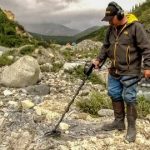California Gold Rush was a transformative event in American history, drawing thousands of prospectors to the western frontier in search of their fortune. The rush for gold not only changed the landscape of California but also had a lasting impact on the economic, social, and cultural fabric of the United States. In this article, we will delve into the hidden stories of the California Gold Rush, shedding light on the often-overlooked narratives of the people who participated in this historic event. Join us as we uncover the untold tales of adventure, hardship, and triumph from one of the most fabled chapters in American history.
“Uncovering the Hidden Stories of the California Gold Rush” is a historical research project aimed at shedding light on the lesser-known aspects of one of the most significant events in American history. The project seeks to unearth and share the stories of marginalized groups, such as women, immigrants, and indigenous peoples, who played a vital but often overlooked role in the gold rush. Through extensive archival research and interviews with descendants of gold rush participants, the project hopes to provide a more inclusive and comprehensive understanding of this pivotal period in California’s history. By bringing these hidden stories to the forefront, the project aims to challenge traditional narratives and offer a more nuanced and accurate portrayal of the California Gold Rush.
The California Gold Rush: A Historic Overview

The California Gold Rush was a significant event in American history that began in 1848 when gold was discovered at Sutter’s Mill. News of the discovery spread rapidly, leading to a mass migration of people from all over the world to California in search of wealth and a better life. The Gold Rush had a profound impact on California’s development, as the population boomed, infrastructure and industries were established, and the state’s economy was transformed. However, the Gold Rush also led to environmental and social consequences, including the displacement and mistreatment of Native Americans, labor exploitation, and environmental degradation. Despite these negative effects, the California Gold Rush remains a symbol of the American Dream and the pursuit of prosperity.
Panning for Gold: The Tools of the California Gold Rush

Panning for Gold: The Tools of the California Gold Rush is a book that explores the various tools and techniques used by prospectors during the 19th-century Gold Rush in California. It delves into the history of the gold rush and provides detailed information on the tools and equipment used for panning for gold, such as pans, shovels, and sluice boxes. The book also discusses the challenges and hardships faced by the prospectors, as well as the impact of the gold rush on California and the nation as a whole. Overall, it offers a comprehensive look at the tools and methods used in the search for gold during this pivotal period in American history.
The Impact of the California Gold Rush on Indigenous Peoples

The California Gold Rush had a significant impact on Indigenous peoples in the region. As settlers rushed to California in search of gold, they encroached on traditional Indigenous lands and disrupted their way of life. Many Indigenous communities were forcibly removed from their ancestral territories, leading to the loss of livelihood and cultural traditions. In addition, the influx of settlers brought disease and violence, causing a drastic decline in Indigenous populations. The California Gold Rush also contributed to the erosion of treaty rights and further marginalization of Indigenous peoples. Overall, the Gold Rush had devastating consequences for the Indigenous communities of California.
Women’s Role in the California Gold Rush
See also: gold detector

Women played a variety of roles during the California Gold Rush of the 1850s. Some women accompanied their husbands to the gold fields and took on domestic and support roles, such as cooking, laundry, and childcare. Others worked as merchants, boarding house operators, or even as gold prospectors themselves. Women also played a key role in creating and maintaining social infrastructure in the gold mining towns, such as organizing churches, schools, and community events. Despite the challenges and hardships they faced, many women found a degree of independence and opportunity in the rapidly changing and often lawless environment of the Gold Rush.
When the Hype Died Down: Life After the California Gold Rush
When the Hype Died Down: Life After the California Gold Rush explores the aftermath of the famous gold rush that occurred in the mid-1800s. The book delves into the impact of the gold rush on the people who flocked to California in search of their fortune, as well as the lasting effects on the state’s economy, environment, and culture. It examines the rise and eventual decline of the gold rush, and how it shaped the future of California. The book also looks at the experiences of those who were left disillusioned and empty-handed after the initial excitement of the gold rush faded, and how they adapted to life in a changed and challenging landscape. Overall, When the Hype Died Down offers a comprehensive look at the legacy of the California Gold Rush and its enduring influence on American history.
The Global Impact of the California Gold Rush
The California Gold Rush had a significant global impact, as it drew people from all over the world to California in search of wealth and opportunity. This mass migration of people had a lasting impact on the demographics and culture of California, with the influx of immigrants from China, Europe, and other parts of the United States contributing to the state’s diverse population.
Additionally, the Gold Rush spurred technological advancements and infrastructure development in California, as the need for efficient ways to extract and transport gold led to innovations in mining, transportation, and communication. This laid the foundation for California’s future growth and prosperity.
The massive increase in gold production also had a significant impact on global trade and finance, contributing to the expansion of the American economy and influencing global markets. The influx of gold from California led to the establishment of the San Francisco Mint and bolstered the United States’ position in the global economy.
Furthermore, the environmental impact of the Gold Rush was substantial, as extensive mining operations led to deforestation, soil erosion, and pollution of waterways. This environmental degradation had long-term consequences for local ecosystems and wildlife.
Overall, the California Gold Rush had far-reaching effects that extended beyond the borders of the United States, shaping the course of history and leaving a lasting impact on the global economy, culture, and environment.
The Chinese Experience in the California Gold Rush
The Chinese experience in the California Gold Rush was fraught with discrimination and hostility. Many Chinese immigrants came to California to seek their fortune in the gold fields, but they were met with prejudice and violence from white miners who viewed them as competition. The Foreign Miner’s Tax of 1850 specifically targeted Chinese miners, requiring them to pay a higher tax than other foreign miners.
Despite the challenges they faced, Chinese immigrants played a significant role in the Gold Rush economy. They worked in gold mining, built infrastructure, and established businesses to support the growing population. However, their contributions were often overlooked and undervalued.
The discrimination and violence against Chinese immigrants led to the formation of Chinese benevolent associations for mutual support and protection. These associations also provided social and cultural support, helping Chinese immigrants maintain their traditions and community in the face of adversity.
The Chinese experience in the California Gold Rush is a complex and often overlooked aspect of American history. Their contributions and struggles deserve recognition in the broader narrative of the Gold Rush and the development of the American West.
The Environmental Impact of the California Gold Rush
The California Gold Rush had a significant environmental impact on the region. Large-scale mining operations led to deforestation, as trees were cut down to build mining infrastructure and support the growing population. The use of hydraulic mining techniques also caused widespread erosion and soil sedimentation in rivers and streams, impacting fish and wildlife habitats.
Mercury, a toxic substance used in gold extraction, contaminated waterways and soil, posing a serious threat to human and environmental health. The rapid population growth and increased demand for resources also led to overhunting, deforestation, and pollution.
The environmental devastation caused by the Gold Rush had long-lasting effects on California’s ecosystems, and efforts to restore and protect the environment continue to this day.
California Gold Rush: Tales of Fortune and Tragedy
The California Gold Rush: Tales of Fortune and Tragedy is a historical account of the famous gold rush that began in 1848. The book includes stories of the prospectors who flocked to California in search of wealth, as well as the hardships and tragedies they faced along the way. The author also delves into the social and economic impact of the gold rush, shedding light on the transformative effects it had on California and the broader United States. The book offers a comprehensive look at this significant event in American history, providing readers with a deeper understanding of the experiences of those who participated in the gold rush.
The Legacy of the California Gold Rush Today
The legacy of the California Gold Rush can still be seen and felt in various aspects of American and Californian society today. The sudden influx of people to California in search of riches led to the expansion and rapid development of the state. The population growth fueled the development of infrastructure, including roads, railroads, and cities, which laid the groundwork for California’s future growth and prosperity.
The Gold Rush also had a significant impact on the economy, as it helped to establish California as a major commercial and financial center. The wealth generated from the Gold Rush contributed to the growth of industries such as agriculture, manufacturing, and trade, which continue to be vital to the state’s economy.
Furthermore, the cultural and demographic diversity that emerged from the Gold Rush remains a defining characteristic of California. The influx of immigrants from all over the world, including Europe, Asia, and Latin America, created a melting pot of cultures that continues to shape California’s identity.
The environmental impact of the Gold Rush is also still evident today. The extensive mining operations and use of hydraulic mining techniques resulted in widespread environmental destruction, which has had lasting consequences on California’s landscape and ecosystems.
In addition, the legacy of the Gold Rush is preserved and celebrated through various historical sites, museums, and cultural events throughout California. These serve as a reminder of the profound impact that the Gold Rush had on the state and its people. Overall, the California Gold Rush has left a lasting legacy that continues to shape the state’s economy, culture, and environment today.









